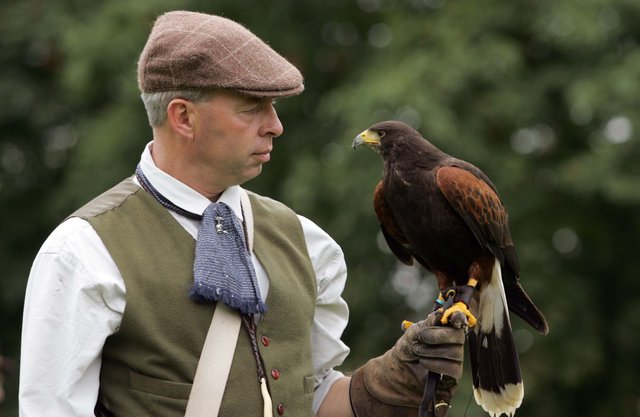Falconry, a Brief History: Sport of Kings and Princes
Nowadays Falconry, mistakenly, is often thought of as a rich man's pastime, though in centuries past this was a common way of putting meat on the table.
Falconry is an ancient pastime that has been practised for millennia. There is some debate over the earliest records of the pastime. An Assyrian bas-relief (which is a form of sculpting, etching away at the surface of a flat stone in order to create a sculpture portrayed as a picture) dating to 722-750BC was been found during the excavation of the palace of Sargon II. Some say the sculpture depicts a falconer holding a hawk on his wrist, others argue that the scene is in effect an archer shooting birds of prey while a servant holds a live captured bird.

image credit
Written records in China date back almost three thousand years. The imperial family of the Chu kingdom 722 -481 BC were hunting with eagles, falcons and short wings using methods that have changed very little to those in use today.
Some historians believe that falconry dates back much further in Arabia or the Middle East, perhaps as far back as eight – ten thousand years. Whatever its true origins it is safe to say that falconry was a well established method of hunting in these areas by the birth of Christ, indeed, it was an established method of hunting, a means of bringing meat to the table.
In the Americas, the first records of falconry date back to New England in 1622, but Spanish Conquistadors noted that the Aztecs used trained hawks for hunting as far back as the 1500s.
Falconry in Europe
The first evidence of falconry in Europe traces it to the sixth century when it was used by the Germanic tribes and by 875 AD it had spread across the whole of the continent and the shores of Britain.
Falconry is said to have been the favourite hunting sport of English Kings from Alfred the Great through to George III, with Royal Falconers held in very high esteem. In Wales, the Master of the Hawks or Penhebogydd was forth in rank from the King and the position came with certain privileges which included the Prince holding his horse when removing the hawks from the game and holding his stirrup when re-mounting. Usually the birds are referred to in three groups: long wings, which are the 'true' falcons such as peregrines, lanners and sakers, short wings which are the 'true' hawks such as goshawk and sparrow hawk, and the broad wings which include eagles and buzzards.
Severe punishments were in place for harming the nest of a falcon and its contents. For example the penalty for destroying an egg could be up to a year in prison and to take a bird from the wild was enough to have the thief's eyes gouged out! To fly a bird above that permitted by your rank or social status could result in having your hand cut off. But the threat of disfigurement was a good enough deterrent as the punishment was rare.

image credit
The Laws of Ownership
By the 1600s English falconry was governed by a strict set of customs known as the Laws of Ownership. These governed not only which social rank could fly which type of bird, but in some cases even what gender of bird. The Laws were laid down in the Boke of St Albans, which has been attributed to Dame Juliana Barnes, prioress of Sopwell nunnery in 1486. The list, which was strictly adhered to, is as follows:
- King: Gyrfalcon, either male or female
- Prince: Peregrine Falcon
- Duke: Rock Falcon
- Earl: Tieral Peregrine
- Baron: Bastarde Hawk
- Knight: Saker
- Squire: Lanner
- Lady: female Merlin
- Yeoman: Goshawk or Hobby
- Priest: female Sparrow hawk
- Holy water clerk: male Sparrow hawk
- Knaves, servants, children: Kestrel
Trained raptors were very valuable birds, indeed, it could be said that they were worth their weight in gold... in 1276 the King of Norway sent eight grey and three white gyrfalcons, the largest of the falcon species, to Edward I as a sign of peace. During the reign of Edward III (1327-1377) the theft of a trained raptor was punishable by death and in the late fourteenth century the Ottoman Sultan Beyazid captured the son of Philip the Bold, Duke of Burgundy. Philip offered a payment of 200,000 gold ducats as a ransom payment for his son, but this was rejected in favour of twelve white gyrfalcons.

image credit
Historically Famous Falconers
Noted falconers include King Harold who is depicted in The Bayeux Tapestry with a falcon and hounds on his visit to William of Normandy. Kublai Khan was believed to be a noted falconer. And in spite of her imprisonment, Mary, Queen of Scots was allowed to hunt larks with her Merlin. Part of the ransom for King Richard's release was two white gyrfalcons. Field Marshall Herman Goering, Commander in Chief of the Luftwaffe was an avid falconer. During the Hitler period, falconry in Germany was taken over by the Government and came under the control of the SS and the Gestapo. Goering controlled five government falcon centres, though he was later joined by Heinrich Himmler.
Unfortunately the art of falconry started to diminish with the invention of the shotgun. Nowadays the only legal way to obtain a bird of prey is to purchase one that is captive bred. It is illegal to take one from the wild other than to treat one that is injured prior to its release. DNA testing can be undertaken by the police and wildlife authorities to determine if a bird was captive bred or not should their suspicions be aroused.
very nice post :)
Great article
Lots of great info there. I really like falcons!